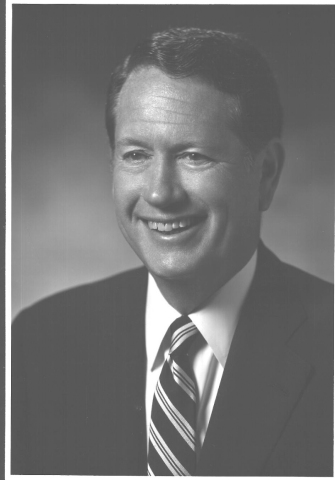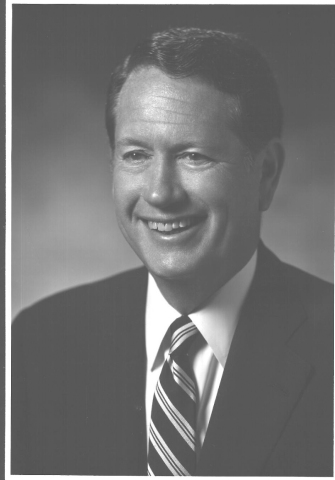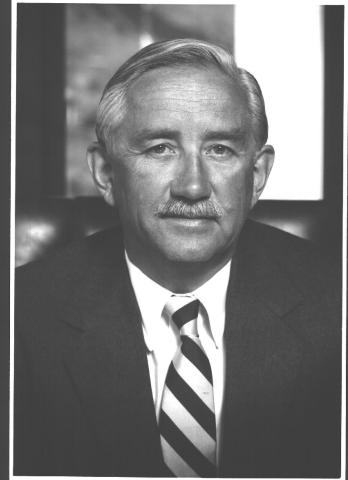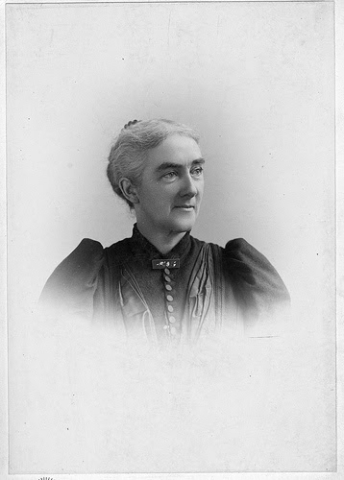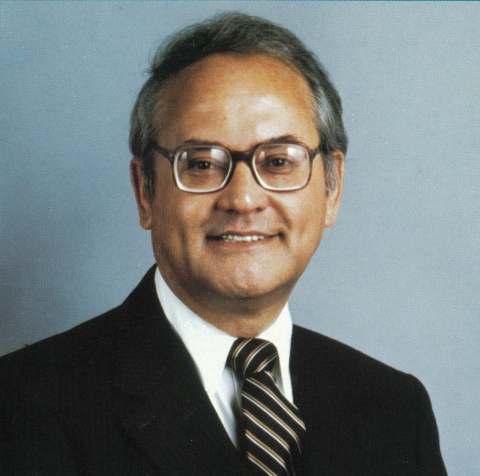LEADVILLE, Colo.--(BUSINESS WIRE)--The National Mining Hall of Fame and Museum (NMHF&M) is pleased to announce the 2014 National Mining Hall of Fame inductees. Representing the domestic and worldwide metal production, education, and health and safety sectors of the industry, this year’s four inductees cover a diverse cross-section of the mining industry.
Harry M. Conger III, Günther Franz (Frank) Joklik, Ellen Swallow Richards, and Dr. Alfred Weiss will join 223 other mining industry pioneers when they are formally inducted into the National Mining Hall of Fame at the 27th Annual Induction Banquet and Ceremony on September 13, 2014. They were selected for being visionaries, leaders, and ambassadors, both within their own sectors and across the industry at large.
2014 National Mining Hall of Fame Inductees:
Harry M. Conger III – Harry M. Conger was a great role model and strong advocate within Homestake Mining Company and among his industry peers on behalf of environmentally responsible, safe, profitable, and high-performance operations. As Chairman and Chief Executive Officer, Conger was instrumental in revitalizing and rebuilding Homestake into an industry leader in technological advances and environmental protection.
Günther Franz (Frank) Joklik – Through his contributions in exploration, project development and operations management as Kennecott President and Chief Executive, Günther Franz (Frank) Joklik did much to strengthen Kennecott as a company and assisted in restoring the competitiveness of the U.S. mining industry.
Ellen Swallow Richards – Ellen Henrietta (Swallow) Richards is generally recognized as the woman who founded ecology. She was the very definition of a pioneer in such diverse fields as chemistry, geology and mineralogy, mining and metallurgy, environmental science, public health, home economics, and education.
Dr. Alfred Weiss – Dr. Alfred Weiss was a true visionary in using quantitative methods and digital computers to aid mineral exploration, plan and design mines, operate mineral production facilities, and integrate the disparate information resources throughout a mining company into a modern management information system.
NMHF&M Board of Directors Chairman Paul C. Jones said, “Again this year we are honored to be able to induct an outstanding group of deserving individuals who have made exceptional contributions to the mining industry in the United States. Included are two ‘living’ inductees who have made significant contributions to management in the industry. One inductee was the first female graduate from the Massachusetts Institute of Technology, its first female faculty member and the first female member of AIME who had an outstanding career as a mineral investigator in the United States. Another inductee was a lifetime innovator in bringing digital technology into common use in our industry. Each of our 2014 inductees made significant and lasting contributions to our industry and are well deserving of becoming a member of the National Mining Hall of Fame.”
Biographies and photographs of all past inductees can be accessed on the NMHF&M web site at www.mininghalloffame.org along with additional information about the museum and its facilities.
2014 Prazen Award Winner – The Board of Directors of the National Mining Hall of Fame and Museum has announced the selection of Pamela A. K. Wilkinson of Scottsdale, AZ as the recipient of the 2014 Prazen Living Legend of Mining Award.
For more than two decades, Pam Wilkinson has been working with various agencies and mining organizations to bring the message of mining to students and adults alike. Her ability to match the message to her audience has made her presentations interesting and engaging. She has developed curricula and programs that deliver accurate information on modern mining practices and the role of minerals in our daily lives. Ms. Wilkinson is currently the Education Outreach Coordinator of the University of Arizona’s Lowell Institute for Mineral Resources, a position funded by the Mining Foundation of the Southwest. In this role, she makes classroom presentations to thousands of students and teachers each year.
The Hall of Fame Induction Banquet and Ceremony is a marquee event for the National Mining Hall of Fame and Museum each year. The 27th Annual Induction Ceremony and Banquet will be held at the Westin Hotel in Denver, Colorado on Saturday, September 13, 2014. For Banquet reservations, contact the NMHF&M office at 719-486-1229. More information is available on the NMHF&M website at www.mininghalloffame.org.
Additional Attachments:
Full-length biographies and photographs of each Hall of Fame inductee.
HARRY M. CONGER III
1930 – Present
Harry M. Conger was a great “role model” and strong advocate within Homestake Mining Company and among his industry peers on behalf of environmentally responsible, safe, profitable, and high-performance operations. As Chairman and Chief Executive Officer, Conger was instrumental in revitalizing and rebuilding Homestake, once the largest gold company in the United States, into an industry leader in technological advances and environmental protection. Joining Homestake in 1975, he applied his extensive prior experience in copper and coal mining and steel in the United States and Canada to meet head-on the rapidly changing government regulations of the 1970s and 1980s. These changing regulations challenged Conger and his Homestake teammates to ensure that all of the Company’s new and existing operations met the new requirements and remained above reproach.
In 1980, under Conger’s leadership, the McLaughlin Deposit in Napa County, California started development and became the largest gold mine in California history. In 1985, the McLaughlin autoclave oxidation plant became the first in the gold industry to profitably extract gold from complex refractory ores. Conger took great risk, including extensive and expensive research on the ores and construction materials, to ensure project success. The autoclave development was critical to project success, while at the same time satisfying the high expectations of its neighbors and of the environmental community working in a sensitive part of northern California. Following start-up, the McLaughlin Mine won great accolades for these efforts. The local community and even the Sierra Club commended Homestake for “exceeding their best expectations” in developing and operating McLaughlin.
Homestake was already established in Australia during Conger’s tenure, but the acquisitions of the El Hueso gold project in Chile in 1988 and International Corona Resources, owner of the gold-rich polymetallic Eskay Creek deposit in British Columbia, Canada in 1992 added significant and successful international projects to Homestake’s portfolio under Conger’s leadership. By expanding operations in Australia, South America, and Canada, Homestake went from being a leading American gold mining company to a highly successful international miner.
Conger was born in Seattle, Washington, served in the U.S. Army Corps of Engineers, graduated from the Colorado School of Mines in 1955 and was later awarded an Honorary Doctorate from his alma mater and also from the South Dakota School of Mines. He served as Chairman of the American Mining Congress and received its Distinguished Service Award. The AIME recognized him for distinguished achievement with the Charles Rand Memorial Award. He led the development and is past Chairman of the World Gold Council, which now represents gold mine operators in over 50 countries. He was a leader in establishing the National Mining Hall of Fame and Museum and served many years as a Trustee. He is also a Trustee of the California Institute of Technology.
Nominated by: Dave Fagin, 2014
GÜNTHER FRANZ (FRANK) JOKLIK
1928 – Present
Through his contributions in exploration, project development and operations management as Kennecott President and Chief Executive, Günther Franz (Frank) Joklik assisted in restoring the competitiveness of the U.S. mining industry. This soft-spoken executive did much to strengthen Kennecott as a company, the local communities where it operated, the state of Utah where it was headquartered and where Joklik made his home, and the United States as a whole.
Joklik successfully led the company through drastic cost reduction measures in the early 1980s and the re-opening of its Utah mining operations in 1986 after falling copper prices had forced the company to shut down operations in 1985. He championed the much-needed modernization of the Bingham Canyon operations and led the diversification of the company into coal and precious metals.
Joklik was born in Vienna, Austria in 1928, and his family immigrated to Australia in 1938, where he grew up. Some of his formative years were spent in the Australian Outback, where the aboriginal people taught him to use a hunting boomerang with deadly accuracy. He attended the University of Sydney, where he received a B.Sc. with First Class Honors and a Ph.D. in Geology. In 1953, he came to the United States as a Fulbright Scholar at Columbia University.
Joklik began his career with Kennecott in 1954 as an exploration geologist. He was responsible for mineral projects in Canada and the United States, based first in Quebec and then at Kennecott’s headquarters in New York City. After ten years, Joklik left Kennecott and returned to Australia with AMAX Inc., where he managed the early development of the Mt. Newman iron ore deposits. With AMAX, he reached the position of Corporate Vice President before returning to Kennecott in 1974. He became President of Kennecott in 1980. Kennecott was purchased by RTZ Corp. PLC in June 1989, and Joklik continued on after the purchase as President and Chief Executive Officer.
Joklik’s leadership in the mining industry did not end with Kennecott. In 1995, he took on the position of President and CEO of MK Resources Co. The company’s primary asset was the Las Cruces copper deposit in southern Spain. Joklik was visionary in demonstrating the viability of the Las Cruces Project and assuring its development. He then played a key role in crafting the transaction whereby MK’s parent company was able to successfully sell 70% of the project in 2005, thereby assuring the financial arrangements for its construction and start-up in 2009. Joklik retired from MK Resources with the successful sale of the Las Cruces asset in 2005.
Joklik received numerous awards and recognitions for his contributions to the mining sector as well as civic and charitable organizations. He is a member of the National Academy of Engineering and served as a director of the American Mining Congress. An avid skier, he also served as Chairman of the 2002 Olympic Winter Games Committee, which successfully brought the winter games to Salt Lake City.
Nominated by: Stan Dempsey, 2014
ELLEN SWALLOW RICHARDS
1842 – 1911
Ellen Henrietta (Swallow) Richards is generally recognized as the woman who founded ecology. She was the very definition of a pioneer in such diverse fields as chemistry, geology and mineralogy, mining and metallurgy, environmental science, public health, home economics, and education. She was probably the first woman to receive a collegiate-level science degree in the United States and among the first to recognize the environmental aspects of mining.
Ellen Swallow was the first woman to attend and graduate from the Massachusetts Institute of Technology in 1873. She also received degrees from Vassar and was later awarded an Honorary Doctor of Science from Smith College in 1910. She was the first female faculty member at MIT, the founder of the Women’s Laboratory there, and the school’s first Dean of Women. In 1875, she became the first woman admitted to membership in the American Institute of Mining Engineers (AIME), where she remained a life-long member.
In 1875, Ellen Swallow married Robert H. Richards, Professor of Mining and Metallurgy at MIT (also a National Mining Hall of Fame inductee). She frequently traveled with her husband on his consulting and student trips to mines, acting as his assayer and colleague. She even taught his mining engineering classes over a two-year period while he recovered from an illness. During trips to the copper region of Michigan’s Upper Peninsula in the early 1880s, she was believed to be the first to establish an environmental baseline for copper in the area.
On her own, Swallow Richards visited and evaluated ore deposits in upper New York State and metalliferous deposits in Maine, Canada and elsewhere. She was likely the first to report on some unknown elements in samarskite, which were later identified by others as samarium and gadolinium. She published “A New Method to Determine Nickel in Pyrrhotites and Mattes,” which she applied to ore from the Coppercliffe Mine, which essentially kicked-off the nickel industry in Ontario with her determination of five percent nickel in a sample of “copper” ore.
Swallow Richards taught a course in mineralogy at the Boston Museum of Natural History to children, school teachers, and Harvard undergraduates. In 1882, she published First Lessons in Minerals for public school students. This book traced elements through fuels, foods, and materials to the human body, and is among the first books published in elementary environmental studies. She has numerous publications to her credit, and her work in food chemistry was among the earliest efforts in understanding the science of human nutrition.
The mining industry can truly claim Ellen Swallow Richards as one of its own. Her relentless spirit to pursue a career in what was without question a “man’s world” at the time, and to become a respected and valued contributor to the industry on her own merit, is testimony of her extraordinary character, perseverance, and commitment to life-long learning.
Nominated by: Frank Aplan 1997; re-nominated by Barbara Arnold, 2014
DR. ALFRED WEISS
1928 – 1998
Dr. Alfred Weiss was a true visionary in using quantitative methods and digital computers to aid mineral exploration, plan and design mines, operate mineral production facilities, and integrate the disparate information resources throughout a mining company into a modern management information system. He demonstrated that potential through projects at Bear Creek Mining Company and at its parent, the Kennecott Copper Corporation. He aided the rapid expansion of mining technical computer applications industry-wide through publications and support of the international APCOM symposia.
As a young mining engineer working for Bear Creek, he discovered the effectiveness of emerging quantitative methods while performing a statistical analysis of the Safford orebody. He moved to Salt Lake City and became the Chief of Bear Creek’s statistical unit. In 1965, Dr. Weiss became the Director of the Kennecott Scientific and Engineering Computer Center. There he assembled his multidisciplinary team. His team would prove the value of computer-based mine planning in Kennecott’s open pit mines. It would also explore promising approaches for process modeling and plant automation using early process control computers and instrumentation. The projects required developing collaborative working relationships with management throughout the company. In 1972, he became the Corporate Director of Technical/Operating Systems in Kennecott’s New York headquarters.
Dr. Weiss and his team members were early and frequent contributors to the dissemination of these advancements through technical papers presented at SME/AIME meetings and in the APCOM Symposia. He served for several years on the APCOM International Council. In 1969, he edited “A Decade of Digital Computing in the Minerals Industry,” which documented the progress of the Computer Age in mining. A companion book followed in 1979.
In 1975, Dr. Weiss became the Assistant Director for Program Development and Evaluation at the U.S. Bureau of Mines in Washington. He returned to the private sector in 1978, first to join EXXON, and then in 1979 to form his own company, Mineral Systems, Inc.
Throughout his career, Dr. Weiss was active in the SME/AIME. He became SME President in 1981. From 1993 until his death in 1998, Dr. Weiss served as the Executive Director of AIME. He received AIME’s prestigious Daniel C. Jackling Award and the Distinguished Service Award.
Alfred Weiss was born into a mining family in Surabaja, Indonesia. His father and grandfather both worked for a Dutch exploration and development company. At the age of ten, for health reasons, he left for Holland only to become entrapped there in 1940 when Germany invaded and occupied the country during World War II. He would not be reunited with his family for seven years. He emigrated to the U.S. in 1950. He received B.S. and M.S. degrees in mining engineering with a minor in mineral economics from the Krumb School of Mines at Columbia University and a Ph.D. from Pace University.
Nominated by: L. Michael Kaas, 2014

